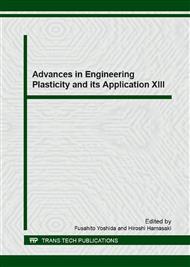p.465
p.471
p.477
p.483
p.489
p.495
p.502
p.511
p.517
Anisotropic Damage Evolution for Perforated Sheet under Tensile Deformation
Abstract:
It is important to formulate a constitutive equation which represents the growth of voids during plastic deformation in order to predict ductile fracture of metallic materials. For this purpose, we proposed an anisotropic Gurson’s yield function with the damage tensor, which represents the anisotropy due to the void distribution and the damage evolution was assumed isotropic for simplicity. Then we also proposed an anisotropic void growth law derived from the anisotropic Gurson’s yield function based on thermodynamic consideration. In this study we carried out the uniaxial tensile test of perforated sheets of stainless steel and aluminum alloy as the ideal two dimensional model of the damaged material and investigate the damage growth during plastic deformation. As a result, we obtained a good agreement between the experimental and the calculated void growth for both materials and it is also found that material parameters for damage evolutions are almost the same for both materials and are hardly affected by the work-hardening exponent.
Info:
Periodical:
Pages:
489-494
Citation:
Online since:
December 2016
Authors:
Keywords:
Price:
Сopyright:
© 2017 Trans Tech Publications Ltd. All Rights Reserved
Share:
Citation:


